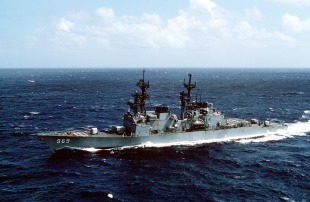Эсминец USS Peterson (DD-969)
Основная информация
Главные размерения
Машина
- 4 * General Electric LM2500 gas turbines
- 2 * shafts, 80,000 shp (60 MW)
Персонал
Боевые силы и средства
- AN/SPS-40 air search radar
- AN/SPG-60 fire control radar
- AN/SPS-55 surface search radar
- AN/SPQ-9 gun fire control radar
- Mark 23 TAS automatic detection and tracking radar
- AN/SPS-65 Missile fire control radar
- AN/SQS-53 bow mounted Active sonar
- AN/SQR-19 TACTAS towed array Passive sonar
- Naval Tactical Data System
- AN/SLQ-32 Electronic Warfare System
- AN/SLQ-25 Nixie Torpedo Countermeasures
- Mark 36 SRBOC Decoy Launching System
- AN/SLQ-49 Inflatable Decoys
- 2 * 5 in (127 mm) 54 calibre Mark 45 dual purpose guns
- 2 * 20 mm Phalanx CIWS Mark 15 guns
- 1 * 8 cell ASROC launcher (removed)
- 1 * 8 cell NATO Sea Sparrow Mark 29 missile launcher
- 2 * quadruple Harpoon missile canisters
- 2 * Mark 32 triple 12.75 in (324 mm) torpedo tubes (Mk 46 torpedoes)
- 1 * 61 cell Mk 41 VLS launcher for Tomahawk missiles
- 2 * Sikorsky SH-60 Seahawk LAMPS III helicopters
USS Peterson (DD-969), honoring Lieutenant Commander Carl Jerrold Peterson (1936–1969), was constructed at the Ingalls Shipbuilding Division of Litton Industries in Pascagoula, Mississippi. Mrs. Miriam C. Peterson, LCDR Carl J. Peterson's mother, acted as the sponsor. Matron of Honor was Peterson's sister, Mrs. John F. Elliott. The ship was commissioned on 9 July 1977 and decommissioned on 4 October 2002.
In 1979, during her initial deployment, Peterson served as the flagship for Commander, Middle East Force in the Persian Gulf and the Indian Ocean. Upon return to Norfolk, Virginia, she was honored with Destroyer Squadron Ten's Battle 'E'.
Peterson embarked on her second deployment in September 1980, also in the Persian Gulf. She returned home in March 1981. Her crew was recognized with the Navy Expeditionary Medal for her role in operations during the final five months of the Iran Hostage Crisis, positioned as the most forward deployed US Navy combatant on «Camel Station» in the Straits of Hormuz.
In 1981, Peterson commenced her third deployment within three years, returning to the Mediterranean on 1 December 1981.
During a significant nine-month overhaul beginning in July 1982, Peterson's weapons systems underwent enhancements, including the installation of the Target Acquisition System (TAS), two 20 mm Vulcan Phalanx CIWS mounts, and an upgraded communications and electronics suite.
In 1984, while deployed in the Mediterranean (Lebanon), Peterson received the Armed Forces Expeditionary Medal for her role as a naval gunfire support ship off the coast of Beirut, Lebanon, as part of the Saratoga battle group in April 1984.
Heading to the Arctic in the Fall of 1985, Peterson took part in the NATO exercise 'Ocean Safari.' This earned her the title of 'Blue Nose' for crossing the Arctic Circle and garnered her the Meritorious Unit Commendation for exceptional service.
In 1986, during her Mediterranean (Libya) deployment with the America battle group, Peterson performed search and rescue duties during combat operations near Libya, earning her the Navy Unit Commendation.
During her 1988 Mediterranean deployment, Peterson served as the flagship for Commander, Destroyer Squadron Twenty Six and collaborated with multiple international navies.
In 1990, Peterson's deployment began in the Mediterranean with the Dwight D. Eisenhower battle group. When civil unrest erupted in Liberia, Peterson hastened to the scene, aiding in the evacuation of more than 1,600 refugees before returning home in September.
Starting in March 1991, Peterson underwent a thirteen-month overhaul, incorporating several modifications to her systems.
In 1993, she embarked on a six-month Middle East Force deployment in the Red Sea, conducting numerous intercepts and boardings in support of United Nations sanctions against Iraq. In response to Iraq's aggression, Peterson struck the Iraqi intelligence headquarters in Baghdad, earning the Destroyer Squadron Two's battle efficiency award for 1993.
Peterson participated in various missions, including supporting Operation Uphold Democracy off the coast of Haiti in July and August 1994, culminating in a successful Mediterranean deployment as part of the Eisenhower battle group in April 1995.
In 1996, Peterson was engaged in counter-drug operations off the coasts of South and Central America in the Eastern Pacific Ocean. Following her return, she underwent training for subsequent deployments.
Deploying with NATO in July 1997 as part of the Standing Naval Forces Atlantic Squadron, Peterson operated alongside several allied navies.
As the flagship for the Standing Naval Forces Mediterranean Squadron in support of NATO, Peterson played a significant role in the Kosovo campaign.
From 2001 to 2002, Peterson completed a deployment supporting Operation Enduring Freedom, involved in various facets of maritime operations in the Persian Gulf. She was notably praised for her efforts during the mission.
Her final underway in 2002 showcased her strength and capability before decommissioning on 4 October 2002. The ship was later sunk in the western North Atlantic Ocean in 2004, supporting weapons effect tests for the DD(X) program. The ship's bell was transferred to Alabama for display at a war memorial. The wreck's location was confirmed in approximately 2,400 m (7,874 ft) of water in 2014.
- Комментарии
 ru
ru en
en uk
uk




 Военно-Морские Силы США
Военно-Морские Силы США Ingalls Shipbuilding
Ingalls Shipbuilding